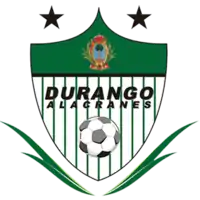Alacranes de Durango
Club de Fútbol Alacranes de Durango, is a Mexican football club based in the city of Durango, Durango, Mexico and currently play in the third level of the professional Mexican football league system. Their colors are green, white with black trim, and their mascot is the scorpion.
 | |||
| Full name | Club de Fútbol Alacranes de Durango | ||
|---|---|---|---|
| Nickname(s) | Los Alacranes (The Scorpions) Los Albiverdes (The White-and-Greens) Los Ponzoñosos (The Poisonous) | ||
| Founded | 12 January 1987 | ||
| Ground | Estadio Francisco Zarco Durango, Durango, Mexico | ||
| Capacity | 18,000 | ||
| Owner | Ciro Castillo Ibarra | ||
| Chairman | Ciro Castillo Ibarra | ||
| Manager | Héctor Jair Real | ||
| League | Liga Premier - Serie A | ||
| 2019–20 | 5th, Group I (Tournament abandoned) | ||
| Website | Club website | ||
|
| |||
History
Foundation
Club Alacranes de Durango was founded in 1958 in the Segunda División de México. In 1992 the club was integrated into the private initiative for four years. Later, in 1996, the Football Club Alacranes de Durango fell under the state government's administration.
The need for a true professional sporting team, after the recent failures of basketball in the twilight of duranguense CIMEBA, prompted the state government to acquire through an application, the franchise of the now defunct Serpientes de Cancún (Cancun Serpents).
Once the league application was approved, Durango returned to professional football after an absence of eight years. During the Torneo Invierno 1997, Durango were as champions of the Zona Norte (North Region) and national runner-up after falling to Monarcas de Zitácuaro for an aggregate score of 3–1.
At the time, head coach Mario "Pichojos" Pérez who played in the 1970 FIFA World Cup, rethought the tactics and had another excellent season in the Torneo Verano 1998, before losing in the final of the Zona Norte (North Region) to Aguascalientes, who won the national final against Monarcas de Zitácuaro resulting in their promotion.
Mario "Pichojos" Pérez & José Vázquez Era
The Torneo Invierno 1998 and Verano 1999 of the Second Division of Mexican Football gave Durango great hope with a good tactical game and planning the perfect pair in Mario "Pichojos" Pérez and José Vázquez. Time and effort rewarded Alacranes de Durango, then under the name of (Camineros de Durango), reached the final on two occasions for the national championship to first beat Monarcas de Zitácuaro 1–0 in the Torneo Invierno 98 and then beat Potros Marte 4–3 in the Torneo Verano 99.
The starting XI that earned promotion for of was:
| Goalkeeper | Defenders | Midfielders | Forwards |
|---|---|---|---|
| Victor Hugo Bermúdez | Luis Alberto "Gallo" Gaytán (captain) | Francisco "Guancha" de la Cruz | |
| Jair Santillán | André Basilio (Brasil) | ||
| Rivelino Robles | |||
| Esteban Mejía | Mauricio Cerecero |
Joining the Primera A
Once Durango gained promotion into the Primera A, their name changed from Camineros de Durango to Alacranes de Durango. The departure of Mario "Pichojos" Pérez and José Vázquez was forced by the separation of the directors of the club.
In their first season in the Primera "A", Alacranes de Durango was led by Guillermo "Campeón" Hernández, a coach who performed well after accepting the role with the club in 20th place overall and leaving Durango in 18th place and in fourteenth in the percentage table.
Alacranes failed to qualify for the playoffs in both the Torneos Invierno 99 and Verano 2000 in the Primera División A. The state government decided to bring order to the professional sport and determined to avoid expenditures of professional basketball and professional baseball to devote their full support to José Velasco Najar and his board of directors, who came to replace the leaving group from the Torneo Invierno 2000. The reaction was swift, Velasco Najar, brought together valuable duranguenses, talented local entrepreneurs and ensured the best decisions on the sporting side.
The recruitment of figures such as a head coach Juan de Dios Castillo and his formidable coaching staff, players such as Gabriel García, a Mexican player with World Cup experience, champion of the Primera División de México, Luis Felipe Peña, whose prestige was formed as a defender for big teams like Club América itself, four young Brazilians who sought a place in Mexican football and an Argentine footballer would come to occupy the goal tending position in Durango, predicted success.
| Goalkeeper | Defenders | Midfielders | Forwards |
|---|---|---|---|
Players
Current squad
- As of 31 January 2021[1]
Note: Flags indicate national team as defined under FIFA eligibility rules. Players may hold more than one non-FIFA nationality.
|
|
Reserve teams
- Alacranes de Durango (Liga TDP)
- Reserve team that plays in the Liga TDP, the fourth level of the Mexican league system.
References
- "Club Durango". Liga BBVA MX (in Spanish). Retrieved 18 September 2020.